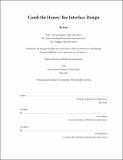Comb the honey : bee interface design
Author(s)
Ren, RiPh. D.Zhong yang mei shu xue yuan (China)
Download1193022067-MIT.pdf (6.446Mb)
Other Contributors
Program in Media Arts and Sciences (Massachusetts Institute of Technology)
Advisor
Neri Oxman.
Terms of use
Metadata
Show full item recordAbstract
The overarching goal of the thesis is to understand the mechanisms by which complex forms are created in biological systems and how the external environment and factors can influence generations over different scales of space, time, and materials. My research focuses on Nature's most celebrated architects -- bees -- and their architectural masterpiece -- the honeycomb. Bee honeycombs are wax-made cellular structures of hexagonal prismatic geometries. Within the comb, bees form their nests, grow their larvae, and store honey and pollen. They operate as a "social womb" informed, at once, by communal (genetic) makeup and environmental forces. Resource sharing, labor division, and unique communication methods all contribute to the magic that is the bee "Utopia." Given that the geometrical, structural, and material make up of honeycombs is informed by the environment, these structures act as environmental footprints, revealing, as a time capsule, the history of its external environment and factors. In this research, a new installation is designed, enabling the bees to achieve their full potentials as a whole; it enhances the abilities of bees for self-regulation and self-organization so as to promote the resilience of bees in the semi-nature at present. The novel bee incubator is a detachable installation that can be recycled to bees every Spring while serving as an observational compartment for researchers. It also presents as artwork for display in museums during Winter. This research thrives on a distinctive vision of diverse interactions of technology, design, science, and art, employing an intricate interface that allows us to heal, replenish, augment, and renew the relationship between humans, bees, and nature.
Description
Thesis: S.M., Massachusetts Institute of Technology, School of Architecture and Planning, Program in Media Arts and Sciences, May, 2020 Cataloged from the official PDF of thesis. Includes bibliographical references (pages 88-90).
Date issued
2020Department
Program in Media Arts and Sciences (Massachusetts Institute of Technology)Publisher
Massachusetts Institute of Technology
Keywords
Program in Media Arts and Sciences